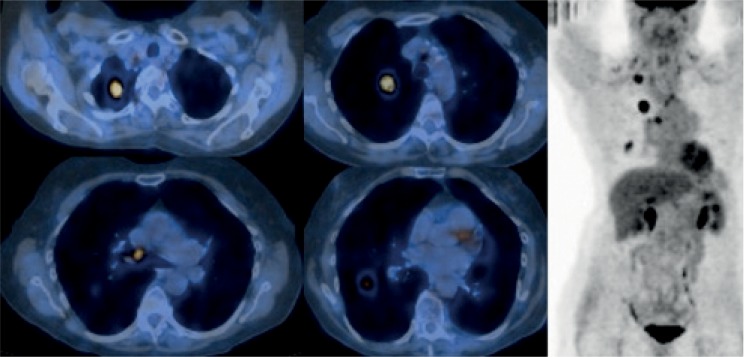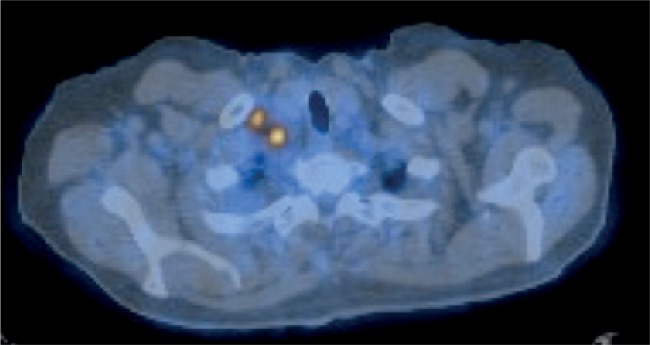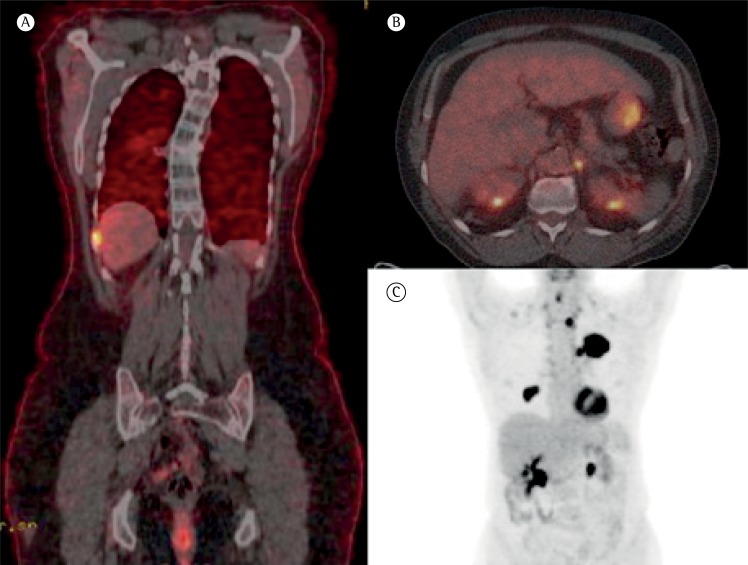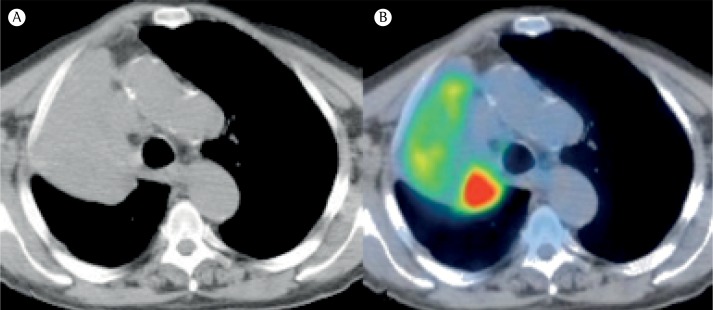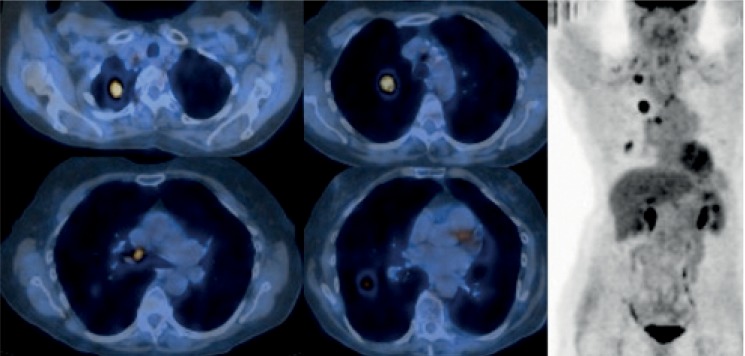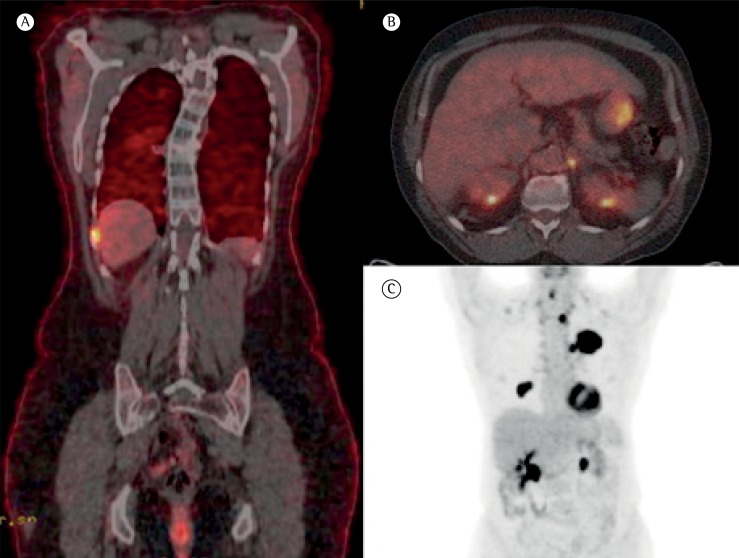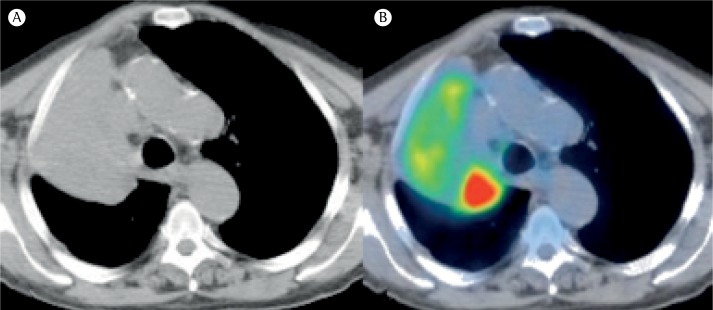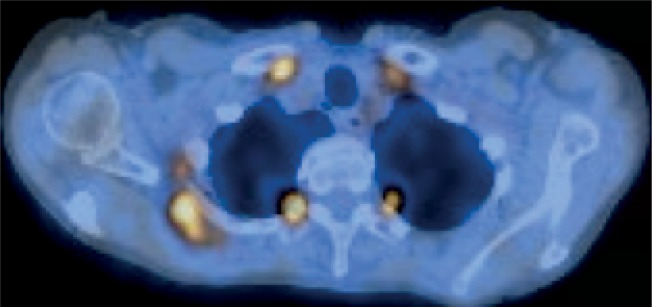Abstract
The use of PET/CT imaging in the work-up and management of patients with lung cancer has greatly increased in recent decades. The ability to combine functional and anatomical information has equipped PET/CT to look into various aspects of lung cancer, allowing more precise disease staging and providing useful data during the characterization of indeterminate pulmonary nodules. In addition, the accuracy of PET/CT has been shown to be greater than is that of conventional modalities in some scenarios, making PET/CT a valuable noninvasive method for the investigation of lung cancer. However, the interpretation of PET/CT findings presents numerous pitfalls and potential confounders. Therefore, it is imperative for pulmonologists and radiologists to familiarize themselves with the most relevant indications for and limitations of PET/CT, seeking to protect their patients from unnecessary radiation exposure and inappropriate treatment. This review article aimed to summarize the basic principles, indications, cancer staging considerations, and future applications related to the use of PET/CT in lung cancer.
Keywords: Carcinoma, non-small-cell lung; Small cell lung carcinoma; Positron-emission tomography; Tomography, X-ray computed; Neoplasm staging
Introduction
The incidence of lung cancer has rapidly increased since the beginning of the 20th century and currently represents the main cause of cancer-related mortality worldwide. The most recent data indicate that, in Brazil as a whole, lung cancer was responsible for 22,424 deaths in 2011, affecting men and women in similar proportions (approximate male/female ratio, 1.6:1.0).( 1 ) Lung cancer also constitutes the second most common type of cancer (in men and women) in Europe and the United States, creating a remarkable burden not only for the health care system but also for society and the economy.( 2 ) Smoking is, independently, the most important risk factor for lung cancer development, the likelihood ratio between smokers and non-smokers having been estimated at 10:1.( 3 ) Non-small cell lung cancer (NSCLC), which is the predominant histology (seen in 85-90% of all cases of lung cancer), encompasses three subtypes: squamous cell carcinoma, adenocarcinoma, and large cell carcinoma. The remaining 10-15% of cases are small cell lung cancer (SCLC).( 4 )
The assessment of patients with suspected lung cancer has routinely included morphological imaging evaluation, with either chest X-rays or CT of the thorax. In addition-although not diagnostic in character-18F-fluorodeoxyglucose positron emission tomography (FDG-PET), bone scintigraphy, and (occasionally) somatostatin receptor scintigraphy have been increasingly incorporated into daily practice in recent decades, providing physicians with useful and complementary information on the functional characteristics of lesions.( 2 ) More recently, the emergence of combined PET/CT imaging has greatly aided the investigation of lung cancer by allowing even better delineation of areas with increased tracer uptake. This modality has helped radiologists avoid the technical difficulties that arose from the independent combination of PET and CT examinations, which resulted in substantial artifacts. In addition, PET/CT has been shown to be an accurate tool for the work-up of solitary pulmonary nodules (SPNs) and for lung cancer staging-by improving the detection of metastatic disease, guiding therapy, and allowing clinical outcomes to be predicted.( 2 , 3 )
Currently, PET/CT is considered a reliable imaging modality that is particularly suitable for the evaluation of cancer patients, including those with lung cancer. Therefore, this study sought to summarize the indications for, findings from, and overall impact of PET/CT on the diagnosis, staging and follow-up of patients with NSCLC and other types of lung cancer.
Indications for PET/CT
Images acquired by PET/CT can be quite useful in the evaluation of suspected or pathologically proven lung cancer cases, in several ways. The most common indications for PET/CT are as follows( 5 , 6 ): for the morphological and functional characterization of pulmonary nodules or masses; for tumor-node-metastasis (TNM) staging of the mediastinum and screening for metastases that might not be detected by CT alone; for radiotherapy planning; and for restaging lung cancer patients following treatment. In addition, PET/CT can offer insights into the histology of a lesion under investigation. Previous studies evaluating the preoperative maximum standardized uptake value (SUVmax) have shown that bronchioloalveolar carcinoma and other well-differentiated tumors are less FDG-avid than are squamous cell carcinomas.( 7 ) Such additional characterizations can also facilitate the differentiation of synchronous primary tumors from metastatic disease, as well as providing prognostic information beyond what is gathered with CT-based imaging.
NSCLC
In up to 90% of all cases of lung cancer, the histological analysis identifies the tumor as NSCLC.( 4 ) In the majority of cases, symptoms will depend heavily on the stage and histological subtype of the tumor. An SPN can be the initial presentation of peripherally located lesions, whereas lobar atelectasis, obstructive pneumonia, or an abnormally enlarged mediastinal lymph node can indicate the presence of central tumors.
Staging
In patients with newly diagnosed NSCLC, the initial disease staging is a crucial step in selecting the most appropriate therapy and determining the prognosis.( 2 ) The TNM staging system, which is kept up-to-date by the American Joint Committee on Cancer and the International Union Against Cancer, is presently the standard tool for staging lung cancer patients. This system is based on a combination of three basic aspects: the location and extent of the primary tumor (T); the presence or absence of changes in intrapulmonary, hilar, or mediastinal lymph nodes (N); and the presence or absence of other pulmonary nodules, pleural effusion, or extrathoracic (distant) metastases (M). The combination of the T, N, and M scores is then used to place a given lesion in one of four disease stages (I-IV), stratifying individuals by prognosis and therapeutic prospects.( 8 - 10 ) An appropriate differentiation between patients with potentially curable disease and those who will be receiving palliative therapies is therefore of utmost importance. In light of this, PET/CT has increasingly supplanted CT as the imaging modality of choice for NSCLC staging, because previous reports have demonstrated that integrated PET/CT is more accurate in characterizing TNM status than is CT alone, PET alone, or visually correlated PET and CT.( 2 , 8 , 10 ) For instance, in the newly adopted 7th edition of the TNM classification for lung cancer, NSCLC metastatic disease is subdivided into M1a, which comprises cases with pleural nodules or malignant pleuropericardial effusion and contralateral pulmonary nodules; and M1b, which comprises those with other distant metastases. Particularly in M1a disease, PET/CT may figure as a useful tool for the detection of either pleural or pericardial metastases, given that previous studies involving PET imaging have reported a methodological inability to outline such lesions precisely.( 11 )
T staging
The T staging describes the location, size, and extent of the primary tumor, as well as the presence or absence of satellite nodules. In general, the extent of a primary lesion can be properly evaluated with thoracic CT. Occasionally, as in cases in which the lesions show superior sulcus involvement, thoracic wall invasion, or close proximity to the heart and large vessels, magnetic resonance imaging (MRI) of the chest can provide useful complementary information.( 8 , 12 )
Given its excellent anatomical resolution, CT remains an important modality for T stage assessment, although its ability to evaluate soft tissue invasion or to distinguish primary lesions from post-obstructive atelectasis is fairly limited. Comparatively, PET imaging provides pertinent data on the metabolic behavior of a lesion, although it is unable to detect microscopic tumor deposits and low-activity nodules (such as adenomas, carcinoid tumors and bronchioloalveolar carcinomas) or to detail important anatomical findings in NSCLC. Nevertheless, PET/CT significantly improves T staging, due to its precise CT correlation with the degree of FDG uptake (Figure 1). Previous studies have demonstrated that integrated PET/CT provides crucial information on mediastinal infiltration and chest wall invasion, as well as allowing the differentiation between tumor and post-obstructive atelectasis, which can present challenges when the T staging of NSCLC is performed with CT alone.( 3 , 13 )
Figure 1. Thoracic PET/CT scans (left) and a PET scan (right), which were performed for the staging of a 57-year-old female patient diagnosed with non-small cell lung cancer. By combining anatomical details with functional data, PET/CT allows more reliable detection of mediastinal and ipsilateral metastatic disease.
Pleural effusion is a relatively common finding in patients with NSCLC, and determining its etiology is decisive for the proper planning of treatment. In cases in which CT and thoracentesis would lack specificity and sensitivity, respectively, PET/CT can allow a more detailed characterization of pleural effusions. Similarly, in cases of suspicious pleural effusions, MRI studies have also been found to be unable to discriminate benign from malignant causes with desirable accuracy.( 3 , 12 ) Finally, although it has been hypothesized that SUVmax would correlate with overall survival in patients with NSCLC, it has yet to be proven to be an independent predictor of survival.( 3 )
N staging
The presence of nodal involvement in lung cancer is of great importance, especially in patients with mediastinal disease but no obvious extrathoracic disease, for whom the N stage will have therapeutic and prognostic implications.( 8 ) Patients staged as N0 or N1 (with no metastatic lymph nodes or metastases in only intrapulmonary/hilar nodes) are generally treated with local intervention, whereas patients with N2 disease (with ipsilateral mediastinal lymph node metastases) might benefit from a combination of local and systemic therapies. Patients with N3 disease (with contralateral mediastinal lymph node metastases) are considered incurable and will eventually receive palliative care.( 3 , 14 )
In daily practice, CT continues to be the most widely used technique for N staging in patients with NSCLC. However, the accuracy of CT imaging for this purpose appears to be limited, because it is based on morphological characteristics only. In this context, mediastinal and hilar lymph nodes with a shortest axis diameter greater than 10 mm are habitually described as enlarged. Nevertheless, the distinction between benign and malignant causes of lymph node enlargement is often challenging, making it difficult to determine whether the detected node presents metastatic disease or the enlargement is inflammatory (reactive) in nature. In addition, upon histological examination, even smaller lymph nodes can reveal lung cancer stage progression.( 15 )
Functional scans obtained with FDG-PET not only complement those obtained with conventional modalities but can have greater sensitivity for N staging, given that alterations in tissue metabolism usually precede anatomical changes. However, the poor spatial resolution of PET and the nonspecific tracing of FDG result in inaccuracies, particularly in areas of normal physiological uptake.
It has been suggested that recent technical advances in MRI techniques, such as magnetization transfer imaging, diffusion weighted imaging, and dynamic enhanced imaging, will improve the overall diagnostic accuracy in mediastinal staging in lung cancer. Further investigation is warranted in order to determine whether chest MRI can figure as an alternative or even surpass PET/CT in its ability to detect nodal involvement. However, previous investigations have pointed out critical advantages of PET/CT over CT and MRI, given the ability of PET/CT to identify neoplastic lymph nodes smaller than 10 mm in diameter.( 3 , 9 )
Despite producing promising results, PET/CT imaging has been shown to have a relatively low positive predictive value (PPV). Especially in virtue of that, the method has not yet proven to be a reliable replacement for CT or MRI imaging as a routine procedure; nor can positive PET/CT findings, such as those shown in Figure 2, eliminate the need for invasive procedures (mediastinoscopy sampling, followed by histological analysis). It is worth noting that PPVs always depend on population characteristics; for example, endemic granulomatous diseases and occupational-related lung disorders can lower the PPV of PET/CT. However, in most patients without findings indicative of malignancy, PET/CT can safely obviate sometimes harmful interventions. Nevertheless, PET/CT can occasionally yield false-negative results in cases of low-growth lesions (either primary or metastatic). Some authors refer to this exceptional situation as "minimal N2", taking into account the better prognosis of such cases in comparison with that of other N2 tumors. In addition, the proximity of various mediastinal structures can occasionally diminish tracer uptake in centrally located malignant nodes.( 8 ) However, it should be borne in mind that PET/CT could be crucial in evaluating nodal sites that are typically inaccessible to mediastinoscopy, such as the aortopulmonary window, anterior mediastinum, and posterior subcarinal nodes. In such cases, it might be advisable to conduct further evaluations by following PET/CT with mediastinotomy, transbronchial biopsy, or endoscopic ultrasound-guided fine needle aspiration.
Figure 2. PET/CT axial scan of a 55-year-old male patient, showing two slightly enlarged supraclavicular lymph nodes, which were suspected of malignancy given their hypermetabolic character and location. Subsequent specimen analyses confirmed the presence of metastatic disease.
In summary, PET/CT appears to represent the best noninvasive modality for the detection of nodal metastasis. However, mediastinoscopy is still the gold-standard method and should be performed whenever there is uncertainty regarding the status of any one lymph node in patients with NSCLC.
M staging
Identification of distant metastases has major implications for management and prognosis of NSCLC, because metastatic disease is present at the time of diagnosis in nearly half of all cases. In addition, among patients who have received radical and supposedly curative therapy, up to 20% are likely to experience recurrence due to undetected foci of metastasis at M staging. Metastatic disease in NSCLC patients demonstrates preferences for (in descending order) the brain, bone, liver, and adrenals.( 14 )
The conventional M staging protocol has long included CT scans of the chest and upper abdomen (liver and adrenal gland screening). When IIIA or IIIB disease occurs, bone scintigraphy and brain imaging (with either CT or MRI) are typically also performed in order to investigate lesions of the bone and central nervous system (CNS), respectively.( 3 ) However, PET/CT imaging has recently shown great utility in the M staging of patients with NSCLC (Figure 3), particularly in those with clinical manifestations of the disease. In addition, PET/CT is able to provide more pertinent information during the preoperative assessment than is CT alone, with the exception of the assessment of brain metastases, for which the two modalities yield similar results and have similar limitations.( 12 )
Figure 3. PET/CT assessment allowing the diagnosis of bone metastases (A) and adrenal metastases (B) in a 79-year-old male patient with non-small cell lung cancer. Although such lesions were suggested by PET alone (C), their precise location and delineation could not be determined without the addition of CT. J Bras.
Adrenal masses are present as an initial finding in up to 20% of all patients diagnosed with NSCLC. ( 8 ) However, approximately two thirds of such masses are found to be adenomas rather than metastases. Abdominal CT assesses adrenal lesions based on their morphological characteristics and attenuation values, which can lead to debatable conclusions in many situations. The increasing use of MRI of the adrenal glands, especially with the recently developed fat-saturation, chemical shift, and dynamic gadolinium-enhanced techniques, has increased the accuracy of the modality in making the distinction between benign and malignant lesions. For the assessment of adrenal masses, PET/CT has also demonstrated high sensitivity and specificity, which could help avoid unnecessary interventions. Nevertheless, false-negative results are possible due to a partial volume effect in very small (< 1 cm) lesions, as well as to hemorrhage, necrosis, or micrometastases, in which FDG uptake can be decreased. Similarly, benign adrenal adenomas can occasionally display high levels of FDG uptake, producing false-positive results. In light of this, histological confirmation is generally recommended when decisions are to be based solely on adrenal lesions.( 8 )
The most widely adopted imaging tool for diagnosing metastatic bone involvement in patients with NSCLC is technetium-99m scintigraphy. It is noteworthy, though, that this method is typically nonspecific, because any hypermetabolic change-such as trauma, arthritis, and degenerative disorders-can cause the method to yield false-positive results. In addition, because of their minimal tissue reaction, lytic and slow-growing metastases can be missed on scintigraphy. For such metastases, PET/CT demonstrates similar sensitivity but greater specificity than does scintigraphy. However, two main limitations of PET/CT regarding metastatic bone disease must be recognized: its routine acquisition protocol includes only the region from head to pelvis; and it can yield false-negative results in the presence of osteoblastic formations, because bone matrix proliferation tends to reduce the glycolytic activity necessary for contrast uptake. Another possible mechanism includes the release of antitumor cytokines, which could contribute to inhibiting FDG uptake.( 3 )
Among all of the potential metastatic sites in NSCLC, the liver is the least challenging, from an imaging standpoint, mainly because it is rarely the only site affected. For decades, the standard investigation for liver metastases comprised ultrasonography and CT, although FDG-PET is more accurate than is CT in detecting liver metastases, primarily due to its better specificity. The PET/CT combination has improved the specificity in detecting liver metastases, although there has been very little gain in sensitivity.( 4 , 6 ) Therefore, the use of PET/CT for the detection of liver metastases is recommended only in the presence of atypical presentations.
Due to the high glucose uptake rate in normal CNS cells, previous experiences with PET/CT for the investigation of brain lesions indicated that the method had very limited specificity. The use of different tracers, such as 11C-methionine, has been suggested in order to offset this limitation, although additional studies are needed in order to validate the use of such tracers as alternatives to FDG. In contrast, MRI studies of the brain have already achieved greater accuracy than PET/CT, remarkably with the development of novel technical improvements, and are currently the state-of-art noninvasive modality for CNS assessment.
The use of PET/CT can also reveal metastases that would otherwise escape detection (e.g., those in soft tissue, retroperitoneal lymph nodes, and small supraclavicular lymph nodes). The benefit of combining conventional CT with PET imaging has been estimated to increase the odds of identifying metastases at those uncommon sites by 5-29%. ( 12 ) Nevertheless, the chance of false-positive results in PET studies must be kept in mind, and histological confirmation should therefore routinely be obtained in surgical candidates who were diagnosed with a single atypical lesion.
In summary, the authors understand that the use of PET/CT can significantly contribute to the staging of NSCLC cases, providing crucial information that can have a major impact on the management of several aspects of the disease. In selected cases, the use of PET/CT in the preoperative phase can reduce the number of patients required to undergo thoracentesis and other futile interventions.( 16 ) It should be borne in mind that, although histology continues to provide the most important information regarding the diagnosis of lung cancer, PET/CT not only can avoid unnecessary procedures but also exhibits great utility when used prior to endobronchial ultrasound, endoscopic ultrasound, or mediastinoscopy.
Radiotherapy and chemotherapy planning
It is currently estimated that approximately 75% of all NSCLC patients could benefit from radiotherapy at some point during their treatment. ( 17 - 19 ) For example, in NSCLC patients who are staged as having I-II disease and are not candidates for surgery (because of cardiopulmonary comorbidities or other reasons), radiotherapy is considered the treatment of choice for increasing overall survival rates.( 19 )
The higher diagnostic accuracy provided by PET/CT has had a major impact on the treatment of lung cancer patients undergoing radiotherapy. That accuracy has improved radiotherapy for lung cancer mainly because it allows the limits of the tumor(s) to be defined with precision, thus preventing mistargeting and the unnecessary irradiation of adjacent structures (Figure 4). For instance, recent studies have demonstrated that the use of PET/CT in the planning of radiotherapy was consistently able to reduce radiation doses for esophageal and pulmonary lesions.( 19 , 20 ) In addition, the higher sensitivity of FDG-PET (in comparison with CT) in detecting abnormal mediastinal lymph nodes has allowed PET/CT to be used in performing target volume delineation using anatomical biological contouring, with even better results.( 3 )
Figure 4. PET/CT images of a 60-year-old male patient diagnosed with non-small cell lung cancer and undergoing radiotherapy. Although a large mass in the right upper lobe was detected on chest CT imaging (A), the differentiation between the tumor and normal surrounding structures would not have been feasible without the aid of PET/CT (B).
In contrast to its usefulness in radiotherapy, PET/CT has thus far proven to be unreliable in the restaging of patients after neoadjuvant chemotherapy. The proper identification of residual N2 disease following neoadjuvant therapy allows the selection of patients who will most likely benefit from surgery. The mean survival for patients restaged as having N0 disease after neoadjuvant therapy and subsequent resection for N2 NSCLC is 28-30 months, whereas the mean survival for those with residual N2 disease is 9-15 months. Similarly, in patients with persistent N2 disease, the five-year survival rate ranges from 0% to 19%, compared with 36% to 43% for those in whom the mediastinal involvement is downstaged after neoadjuvant therapy. However, the results of several studies have indicated the need for pathological confirmation of PET/CT findings after neoadjuvant therapy.( 17 , 21 , 22 )
Cost-effectiveness of PET/CT in NSCLC staging
The relative superiority of PET/CT over conventional modalities for oncological staging has been reported with increasing frequency. However, whether this method should be widely applied in daily practice remains under debate because of its extremely high cost.( 14 ) In many situations, findings that appear to be pathological on PET/CT will require further (invasive) investigation, which will also increase health care system expenditures. The current costs of PET/CT notwithstanding, some authors believe-based on its potential to inform the decision-making process-that it will increase the life expectancy of and provide other benefits to patients with NSCLC, as well as that it might, in the near future, cut health system expenditures by precluding the need for (invasive or noninvasive) diagnostic procedures.( 23 , 24 )
Limitations of PET/CT in NSCLC staging
Although PET/CT has proven to be a particularly promising modality in NSCLC staging, several pitfalls must be taken into account when interpreting PET/CT findings. When the physiological or anatomical registration is imprecise, which most commonly occurs in areas close to the diaphragm or the heart, there can be misregistration artifacts-resulting in misalignment between the CT and PET scans during acquisition. Such discrepancies can allow microlesions to go unnoticed, producing false-negative results.( 7 )
As a general rule, SUVmax values ≥ 2.5 are considered indicative of malignant processes, whereas tumors showing an SUVmax < 2.5 are more likely to be benign. However, many conditions that increase metabolic activity can lead to increased FDG uptake on PET/CT imaging (Figure 5), thus producing numerous challenging situations. Such conditions include infections (such as tuberculosis and aspergillosis), inflammation (iatrogenic or caused by rheumatoid arthritis or amyloidosis), and even pulmonary infarction. In addition, the physiological uptake of FDG that is typically present in the brain, heart, gastrointestinal tract, genitourinary tract, and striated muscles can occasionally give the impression of increased FDG uptake on PET/CT imaging, leading to false-positive results.( 14 ) Another cause of false-negative FDG uptake is inherent to the technological limitations of PET/CT and to the properties of tumor cells. Lesions that measure less than two to three times the spatial resolution of the scanner will usually appear less active due to the partial volume effect. Furthermore, lesions containing few cells, or cells with low metabolic rates, such as highly differentiated tumors, can also create pitfalls in PET/CT interpretation.( 8 )
Figure 5. PET/CT scan of the chest, revealing numerous areas of high 18F-fluorodeoxyglucose uptake in a 72-year-old male patient with osteoarthritis. In this case, the greater uptake arose from the abnormal inflammatory status, which led to higher glucose consumption.
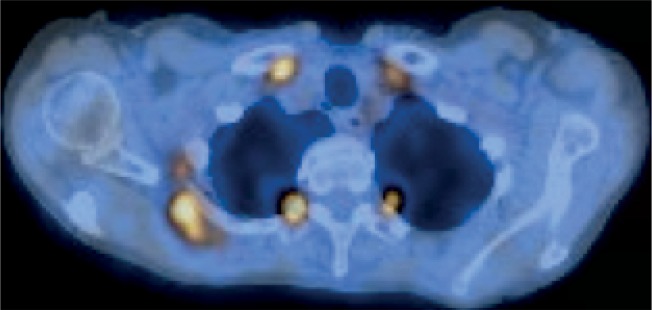
SCLC
Because of its high metastatic potential, SCLC is considered the most aggressive form of lung cancer. It is estimated that SCLC accounts for approximately 10-15% of all lung cancer cases. The overall prognosis is remarkably severe. Although SCLC is usually chemosensitive in the early stages, most patients with SCLC will experience recurrences that ultimately lead to death. The association with active smoking is as evident as in NSCLC, and nearly all SCLC patients (over 95%) are current or former smokers.( 3 )
Traditionally, SCLC has been divided into two stages-limited disease and extensive disease-in accordance with the criteria established by the Veterans Administration Lung Group.( 25 ) Limited disease comprises lesions that are confined to one hemithorax, to the mediastinum, and to the supraclavicular lymph nodes. All other presentations, including those with malignant pleural effusion, are categorized as extensive disease. The fact that almost 70% of patients with SCLC are classified as having extensive disease at diagnosis illustrates the significant morbidity of this form of cancer.( 13 )
The poor prognosis of SCLC notwithstanding, tumor staging is quite important in patients with SCLC, because it can increase survival and improve quality of life. Available therapies in SCLC treatment include radiotherapy and chemotherapy regimens, although patients with extensive disease are typically treated with chemotherapy regimens alone. Within this context, the accurate staging of SCLC can also have implications for the periodicity of follow-up evaluations, as well as for the determination of toxicity profiles and the prognostic assessment.( 25 )
The usefulness of PET imaging in SCLC disease staging has been validated, PET findings having been shown to lead to therapeutic modifications in 10-33% of cases.( 13 ) In view of this, the use of PET/CT might allow an even better assessment of SCLC. Patients could benefit from correct PET/CT-based upstaging from limited disease to extensive disease, which would reduce ineffective approaches and prevent unnecessary patient suffering. In addition, on the basis of PET/CT findings, patients with indeterminate M stage could be correctly downstaged from extensive disease to limited disease (or very limited disease) and, in some cases, could be offered potentially curative treatments. Furthermore, the targeted volume during radiotherapy could be more precisely outlined by PET/CT, and that volume could be adapted for additional metastatic sites.( 13 ) Nevertheless, because of high neural glucose consumption, PET/CT has limited diagnostic value in the evaluation of brain metastases. Therefore, in cases of suspected CNS involvement, methionine-PET and MRI are preferable to PET/CT.( 3 ) Moreover, PET/CT might be ineffective in detecting the occurrence of micrometastases, which underscores the recommendation for the use of PET/CT mainly in the early stages of SCLC, when it has the potential to inform decisions regarding the planning and modification of local treatments.
The capacity of PET imaging to assess treatment response has proven to be useful in SCLC, in which most tumors will undergo functional changes before undergoing anatomical changes. There is evidence that PET can detect early-stage disease, as well as residual disease in scar tissue or otherwise unsuspicious structures. In addition, it has been demonstrated that there is a positive relationship between SUVmax values and overall survival rates in SCLC.( 3 ) In view of the fact that the natural history of SCLC indicates an unfavorable prognosis, the prediction/early detection of a response to treatment is crucial and should be always encouraged.( 25 )
SPNs
Many patients with early stage lung cancer will present with an SPN, defined as a single spherical or oval lesion that is less than 3 cm in diameter and is completely surrounded by pulmonary parenchyma without accompanying atelectasis or lymph node enlargement.( 2 ) A very important step in investigating the etiology of an SPN is to determine whether it is benign or malignant in nature. However, the critical dilemma regarding the assessment of SPNs is that they are common, affecting between 0.1% and 0.2% of adults, and it is not always possible to rule out malignancy with conventional CT imaging. For lesions that are greater than 8 mm in diameter, evaluation with PET/CT might be advisable in patients who are at low or moderate risk for malignancy (5-20% and 20-80% of all patients with an SPN, respectively), depending on their radiological characteristics. In addition, PET/CT could benefit patients at high risk for SPN malignancy, by evaluating the local extent of the mass and detecting distant metastases.( 26 ) Although CT remains an excellent modality for SPN evaluation, given its extremely high sensitivity, its specificity tends to be limited. The recent introduction of PET/CT imaging into clinical practice has had a positive impact on diagnostic specificity in patients presenting with SPNs, because it provides functional and anatomical data.( 27 ) However, there are a number of pitfalls to be considered during the assessment of SPNs with PET. In patients with inflammatory conditions or infections-such as bacterial or fungal infections; granulomatous diseases (tuberculosis, sarcoidosis, histoplasmosis, etc.), and pyogenic abscesses-there is a greater likelihood of higher metabolic activity due to increased granulocyte or macrophage activity,( 27 - 29 ) and such comorbidities have become a cause for great concern in some regions of Brazil. Patient body size, patient blood glucose concentration, and the timing of PET acquisition can also hinder the interpretation of the results. Therefore, PET results for patients with uncontrolled diabetes or very poor clinical status can be especially difficult to interpret. In addition, PET can yield false-negative results due to the relatively limited spatial resolution of PET cameras, which is currently up to approximately 7-8 mm. Consequently, the metabolic activity level of smaller masses must be relatively high in order to become evident on PET imaging, and lesions < 1 cm in diameter or demonstrating low metabolic activity can occasionally be missed by PET scans.( 2 )
Newer directions in tracers: beyond FDG
Because PET/CT is now an established modality in the management of lung cancer, novel radiopharmaceuticals have been widely investigated, in various aspects of tumor biology, in order to broaden the applications for and accuracy of this imaging method. Improvements include the increasingly widespread use of 18F-fluorothymidine, which is considered to be even more sensitive than is standard 18F-FDG for evaluating early treatment responses. Other tracers have been found to provide information regarding various conditions and processes, including hypoxia (18F-fluoromisonidazole and 64Cu-ATSM), angiogenesis (RGD peptides), amino acid metabolism (11C-methionine), and choline metabolism (11C-choline and 18F-fluorocholine).
An additional matter of interest is the noninvasive analysis (with PET imaging) of epidermal growth factor receptor (EGFR) and EGFR tyrosine kinase overexpression in tumors. Albeit quite infrequently, the suspicion of such tumors can occasionally be raised by the presence of isolated pleural effusion or miliary metastases. ( 14 , 30 ) It has been demonstrated that PET has the potential for in vivo, a priori determination of EGFR-targeted drug efficacy. The newly developed tracers described above might provide better insight into tumor behavior and therapy-related toxicity, thereby facilitating the formulation of individualized treatment strategies. However, the incipient results will require further corroboration before being applicable to daily practice.( 22 )
Final considerations
The use of PET/CT scans has become a reliable tool that can complement and sometimes take the place of conventional imaging modalities in the radiological assessment of lung cancer. The most widely employed radiotracer, 18F-FDG, provides critical information about the biological aggressiveness of a tumor and the corresponding prognosis. Particular attention is advised when using PET/CT in the investigation of diabetic patients, as well as in regions where there is high prevalence of infectious and inflammatory conditions. For NSCLC and SCLC, PET/CT has revolutionized staging and the planning of treatment. Nevertheless, radiologists and pulmonologists should become familiar with the potential pitfalls that they might encounter in their interpretation of PET/CT findings.
Footnotes
Study carried out under the auspices of the Graduate Program in Radiology, Federal University of Rio de Janeiro, Rio de Janeiro, Brazil.
Financial support: None.
References
- 1.Ministério da Saúde.Instituto Nacional do Câncer José Alencar Gomes da Silva . ipos de Câncer: Pulmão. http://www2.inca.gov.br/wps/wcm/connect/tiposdecancer/site/home/pulmao/definicao [Google Scholar]
- 2.Sharma P, Singh H, Basu S, Kumar R. Positron emission tomography-computed tomography in the management of lung cancer: An update. South Asian J Cancer. 2013;2(3):171–178. doi: 10.4103/2278-330X.114148. [DOI] [PMC free article] [PubMed] [Google Scholar]
- 3.Ambrosini V, Nicolini S, Caroli P, Nanni C, Massaro A, Marzola MC. PET/CT imaging in different types of lung cancer: An overview. Eur J Radiol. 2012;81(5):988–1001. doi: 10.1016/j.ejrad.2011.03.020. [DOI] [PubMed] [Google Scholar]
- 4.Takeuchi S, Khiewvan B, Fox PS, Swisher SG, Rohren EM, Bassett RL., Jr Impact of initial PET/CT staging in terms of clinical stage, management plan, and prognosis in 592 patients with non-small-cell lung cancer. Eur J Nucl Med Mol Imaging. 2014;41(5):906–914. doi: 10.1007/s00259-013-2672-8. [DOI] [PubMed] [Google Scholar]
- 5.Shreve P, Faasse T. Role of Positron Emission Tomography-Computed Tomography in Pulmonary Neoplasms. Radiol Clin North Am. 2013;51(5):767–779. doi: 10.1016/j.rcl.2013.05.001. [DOI] [PubMed] [Google Scholar]
- 6.Westphal FL, Lima LC, Lima-Netto JC, Tavares Mde A, Gil Fde S. Lung cancer and schwannoma--the pitfalls of positron emission tomography. J Bras Pneumol. 2014;40(3):319–321. doi: 10.1590/S1806-37132014000300016. [DOI] [PMC free article] [PubMed] [Google Scholar]
- 7.Cuaron J, Dunphy M, Rimner A. Role of FDG-PET scans in staging, response assessment, and follow-up care for non-small cell lung cancer. Front Oncol. 2013;2:208–208. doi: 10.3389/fonc.2012.00208. [DOI] [PMC free article] [PubMed] [Google Scholar]
- 8.Chao F, Zhang H. PET/CT in the Staging of the Non-Small-Cell Lung Cancer. J Biomed Biotechnol. 2012;2012:783739–783739. doi: 10.1155/2012/783739. [DOI] [PMC free article] [PubMed] [Google Scholar]
- 9.Chansky K, Sculier JP, Crowley JJ, Giroux D, Van Meerbeeck J, Goldstraw P. The International Association for the Study of Lung Cancer Staging Project: prognostic factors and pathologic TNM stage in surgically managed non-small cell lung cancer. J Thorac Oncol. 2009;4(7):792–801. doi: 10.1097/JTO.0b013e3181a7716e. [DOI] [PubMed] [Google Scholar]
- 10.Tsim S, O'Dowd CA, Milroy R, Davidson S. Staging of non-small cell lung cancer (NSCLC): a review. Respir Med. 2010;104(12):1767–1774. doi: 10.1016/j.rmed.2010.08.005. [DOI] [PubMed] [Google Scholar]
- 11.Duysinx B, Corhay JL, Larock MP, Withofs N, Bury T, Hustinx R. Contribution of positron emission tomography in pleural disease. Rev Mal Respir. 2010;27(8):e47–e53. doi: 10.1016/j.rmr.2009.12.003. [DOI] [PubMed] [Google Scholar]
- 12.Sahiner I, Vural GU. Positron emission tomography/computerized tomography in lung cancer. Quant Imaging Med Surg. 2014;4(3):195–206. doi: 10.3978/j.issn.2223-4292.2014.03.05. [DOI] [PMC free article] [PubMed] [Google Scholar]
- 13.Hellwig D, Baum RP, Kirsch C. FDG-PET, PET/CT and conventional nuclear medicine procedures in the evaluation of lung cancer: a systematic review. Nuklearmedizin. 2009;48(2):59–69. doi: 10.3413/nukmed-0217. [DOI] [PubMed] [Google Scholar]
- 14.Rankin S. PET/CT for staging and monitoring non small cell lung cancer. Cancer Imaging. 2008;8(A):S27–S31. doi: 10.1102/1470-7330.2008.9006. [DOI] [PMC free article] [PubMed] [Google Scholar]
- 15.Nomori H, Ohba Y, Yoshimoto K, Shibata H, Shiraishi K, Mori T. Positron emission tomography in lung cancer. Gen Thorac Cardiovasc Surg. 2009;57(4):184–191. doi: 10.1007/s11748-008-0371-3. [DOI] [PubMed] [Google Scholar]
- 16.Taus Á, Aguiló R, Curull V, Suárez-Piñera M, Rodríguez-Fuster A, Rodríguez de Dios N. Impact of 18F-FDG PET/CT in the treatment of patients with non-small cell lung cancer. Arch Bronconeumol. 2014;50(3):99–104. doi: 10.1016/j.arbres.2013.09.017. [DOI] [PubMed] [Google Scholar]
- 17.Broderick SR, Patterson GA. Performance of integrated positron emission tomography/computed tomography for mediastinal nodal staging in non-small cell lung carcinoma. Thorac Surg Clin. 2013;23(2):193–198. doi: 10.1016/j.thorsurg.2013.01.014. [DOI] [PubMed] [Google Scholar]
- 18.Goldstraw P, Ball D, Jett JR, Le Chevalier T, Lim E, Nicholson AG. Non-small-cell lung cancer. Lancet. 2011;378(9804):1727–1740. doi: 10.1016/S0140-6736(10)62101-0. [DOI] [PubMed] [Google Scholar]
- 19.De Ruysscher D, Nestle U, Jeraj R, Macmanus M. PET scans in radiotherapy planning of lung cancer. Lung Cancer. 2012;75(2):141–145. doi: 10.1016/j.lungcan.2011.07.018. [DOI] [PubMed] [Google Scholar]
- 20.Zheng Y, Sun X, Wang J, Zhang L, DI X, Xu Y. FDG-PET/CT imaging for tumor staging and definition of tumor volumes in radiation treatment planning in non-small cell lung cancer. Oncol Lett. 2014;7(4):1015–1020. doi: 10.3892/ol.2014.1874. [DOI] [PMC free article] [PubMed] [Google Scholar]
- 21.Skoura E, Datseris IE, Platis I, Oikonomopoulos G, Syrigos KN. Role of positron emission tomography in the early prediction of response to chemotherapy in patients with non--small-cell lung cancer. Clin Lung Cancer. 2012;13(3):181–187. doi: 10.1016/j.cllc.2011.05.004. [DOI] [PubMed] [Google Scholar]
- 22.Behzadi A, Ung Y, Lowe V, Deschamps C. The role of positron emission tomography in the management of non-small cell lung cancer. Can J Surg. 2009;52(3):235–242. [PMC free article] [PubMed] [Google Scholar]
- 23.Langer A. A systematic review of PET and PET/CT in oncology: a way to personalize cancer treatment in a cost-effective manner? BMC Health Serv Res. 2010;10:283–283. doi: 10.1186/1472-6963-10-283. [DOI] [PMC free article] [PubMed] [Google Scholar]
- 24.Cao JQ, Rodrigues GB, Louie AV, Zaric GS. Systematic review of the cost-effectiveness of positron-emission tomography in staging of non--small-cell lung cancer and management of solitary pulmonary nodules. Clin Lung Cancer. 2012;13(3):161–170. doi: 10.1016/j.cllc.2011.09.002. [DOI] [PubMed] [Google Scholar]
- 25.Joyce EA, Kavanagh J, Sheehy N, Beddy P, O'Keeffe SA. Imaging features of extrapulmonary small cell carcinoma. Clin Radiol. 2013;68(9):953–961. doi: 10.1016/j.crad.2013.04.006. [DOI] [PubMed] [Google Scholar]
- 26.Shon IH, O'doherty MJ, Maisey MN. Positron emission tomography in lung cancer. Semin Nucl Med. 2002;32(4):240–271. doi: 10.1053/snuc.2002.126059. [DOI] [PubMed] [Google Scholar]
- 27.Truong MT, Viswanathan C, Erasmus JJ. Positron Emission Tomography/Computed Tomography in Lung Cancer Staging, Prognosis, and Assessment of Therapeutic Response. J Thorac Imaging. 2011;26(2):132–146. doi: 10.1097/RTI.0b013e3182128704. [DOI] [PubMed] [Google Scholar]
- 28.Opoka L, Kunikowska J, Podgajny Z, Szolkowska M, Blasinska-Przerwa K, Burakowska B. Accuracy of FDG PET/CT in the evaluation of solitary pulmonary lesions - own experience. Pneumonol Alergol Pol. 2014;82(3):198–205. doi: 10.5603/PiAP.2014.0027. [DOI] [PubMed] [Google Scholar]
- 29.Allen TL, Kendi AT, Mitiek MO, Maddaus MA. Combined contrast-enhanced computed tomography and 18-fluoro-2-deoxy-D-glucose-positron emission tomography in the diagnosis and staging of non-small cell lung cancer. Semin Thorac Cardiovasc Surg. 2011;23(1):43–50. doi: 10.1053/j.semtcvs.2011.05.003. [DOI] [PubMed] [Google Scholar]
- 30.Revel MP, Carette MF, Torrent M, Trédaniel J. Diagnosis and standardized report for non-small cell lung cancer. Diagn Interv Imaging. 2014;95(7-8):727–738. doi: 10.1016/j.diii.2014.06.007. http://dx.doi.org/10.1016/j.diii.2014.06.007 [DOI] [PubMed] [Google Scholar]



